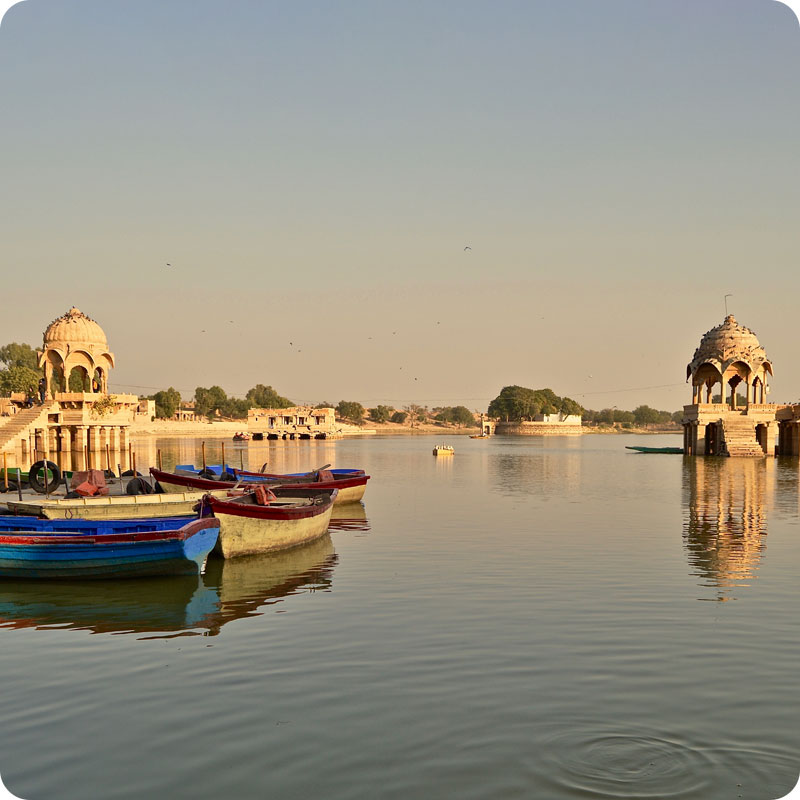
Attractions in Jaisalmer
Enhance your trip to Jaisalmer by learning a bit more about some of the popular major attractions in Jaisalmer.
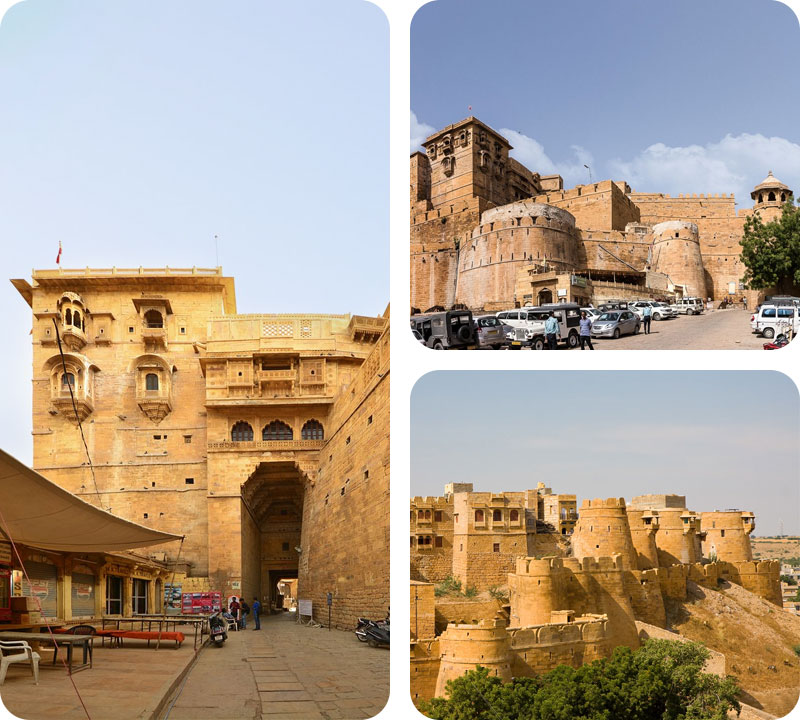
Jaisalmer Fort
The Jaisalmer Fort is among the most lively historical monuments in the world that is definitely worth a visit. It was built by Maharaja Jaisal Singh in 1156 AD and is considered the second oldest fort in Rajasthan. The unique thing about the Jaisalmer Fort is that it still serves as the abode for over 3000 people.
Its well-planned archaeological design with narrow to wide lanes surely gives you a glimpse of the begone era of the Royals. The fort is constructed using yellow sandstone that changes its colours throughout the day, earning it the name of the ‘Golden Fort’ or ‘Sonar Killa’.

Havelis in Jaisalmer
As Jaisalmer flourished under a dynasty and served as a trade center in the begone era, it got some unique archaeological marvels making it popular as the ‘City of Havelis’. These havelis were constructed either in pure Rajputana architecture or a blend of Rajputana & Mughal architecture and are a must visit attraction.
There are only 3 major havelis in Jaisalmer which in order of their build period are Patwo ki Haveli, Nathmal ki Haveli and Salim Singh ki Haveli. All these havelis are now preserved as heritage museums and are quite popular tourist attractions which are open to the public during regular work hours.
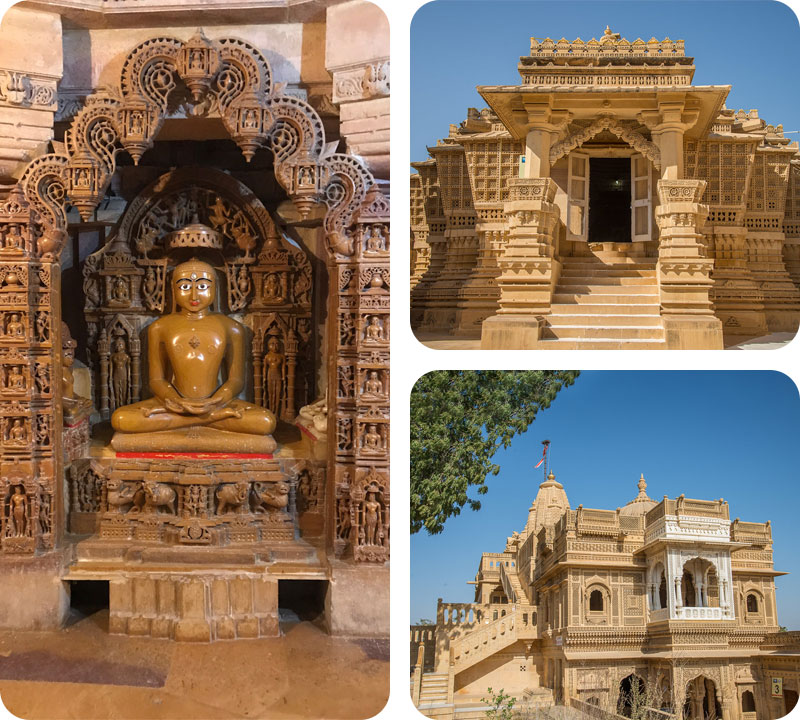
Jain Temples in Jaisalmer
As Jaisalmer lied on the wealthy silk route, it was home to various jain traders and attracted various looters & invaders. Tired of the invaders, King Jaisal Raval built the fort to safeguard its people and the interest of the Jains. In return, the wealthy Jains financed the construction of the Fort.
There are various ancient Jain temples within the fort and a few are around the city, which act as a major pilgrimage site for the Jains. Moroever, these Jain temples contain beautiful frescoes, mirrors and other forms of detailing that are the perfect example of the Dilwara style architecture.
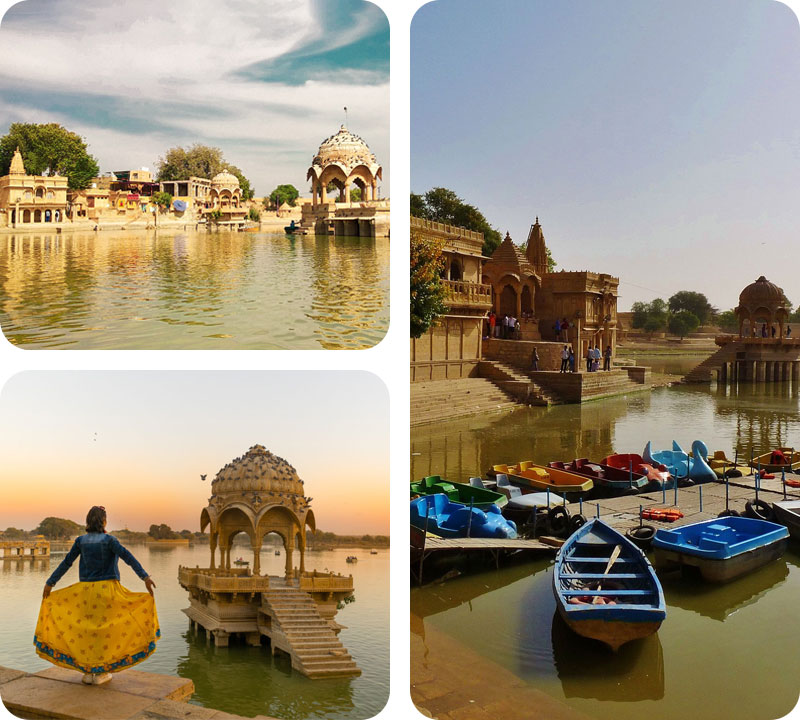
Gadisar Lake
The Gadisar lake was also built by Raja Jaisal Singh in 1156 AD to quench the thirst of the people of his kingdom. It is a major tourist attraction in Jaisalmer and this beautiful man-made lake is surrounded by temples, shrines and a forest area which acts as the perfect backdrop for picturesque photographs.
There are a few ancient temples on the banks that are dedicated to Lord Shiva and the stairs serve as an ideal romantic spot to watch the enchanting sunset. One can enhance his/her staying experience by opting to boat in the lake. The ideal time for visiting the lake is either before 11:00 AM or after 4:30 PM.
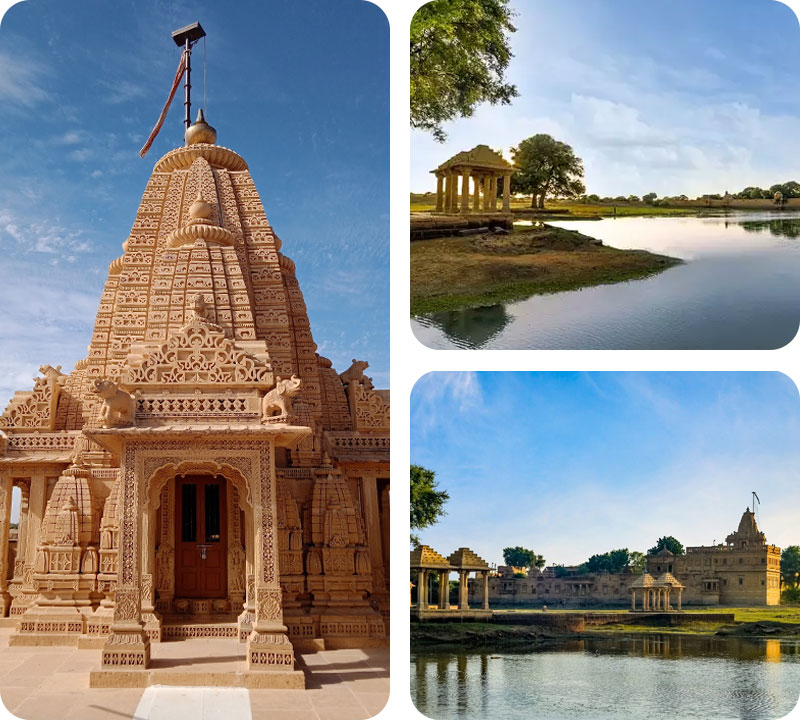
Amar Sagar
Amar Sagar is famous for its beautiful lake that was built by Raja Akhai Singh for his predecessor Raja Amar Singh during the 17th century. The lake was re-built by Patwa Bafna Himmat Ram in 1928 and boasts of beautiful stone carvings in the temples adjacent to the lake.
The calm water of the lake brings in a feeling of peace and solitude. There is also a famous, yet beautiful Jain temple situated nearby which is dedicated to Lord Parshvanath. The best time to visit the lake is also before 11 am and after 4:30 pm. The lake is considered auspicious and boating is not allowed here.
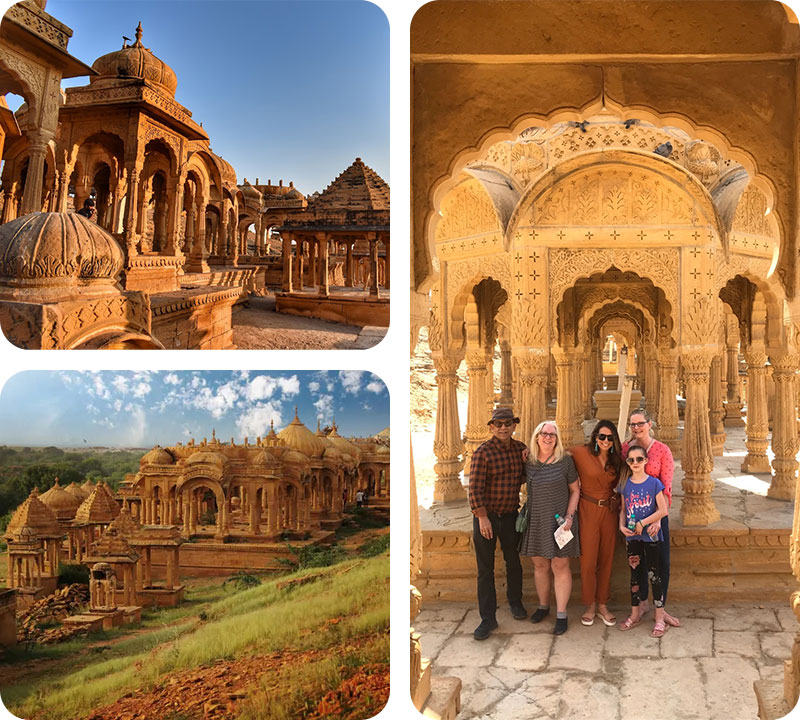
Bada Bagh
The Bada Bagh is the cremation site for the royals of Jaisalmer i.e. the kings, his nobles and some brave warriors. The place basically means a ‘big garden’, a garden of beautifully carved cenotaphs and is one of the major tourist attraction in Jaisalmer. It has its own vibe and you’ll find it quite calm & peaceful here.
This place provides a glimpse into the history of Jaisalmer and in order to preserve its heritage and worthiness, you will not find any description stones or inscriptions here. It is a popular tourist attraction for photoshoots and the best time to visit it is either early morning or in the evening.
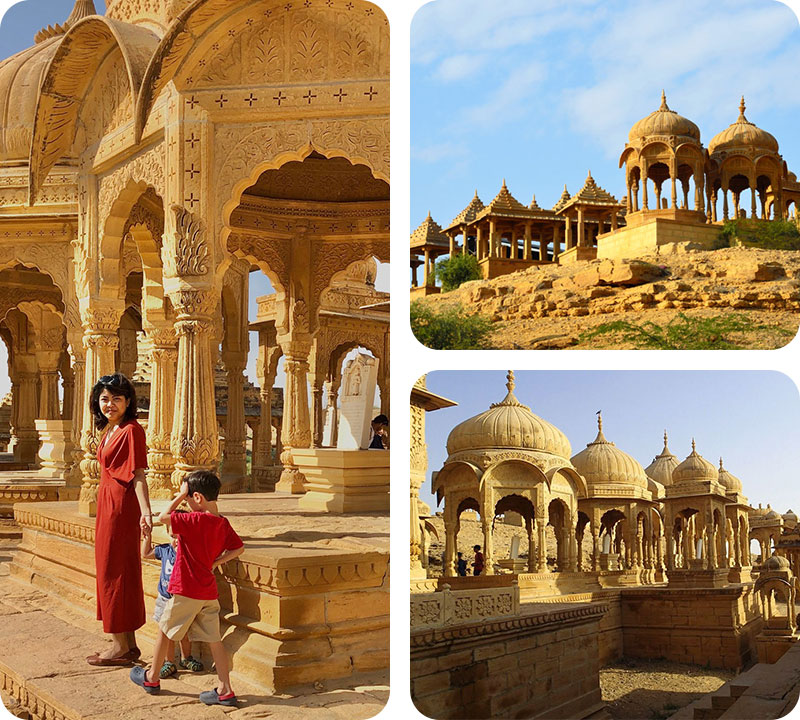
Vyas Chattri
The Vyas Chattri has also been used as the cremation site for the Brahmins of Jaisalmer. This place is situated next to the city and also looks much like the Bada Bagh. It has a lot of cenotaphs or chattris but they are fewer in number here as compared to Bada Bagh.
This place is quite peaceful and it also offers a glimpse into the relations of the Brahmins with the Rajputs. It is also a popular tourist attraction where a lot of people come to take selfies and portraits. The best time to visit it is either early morning or in the evening.
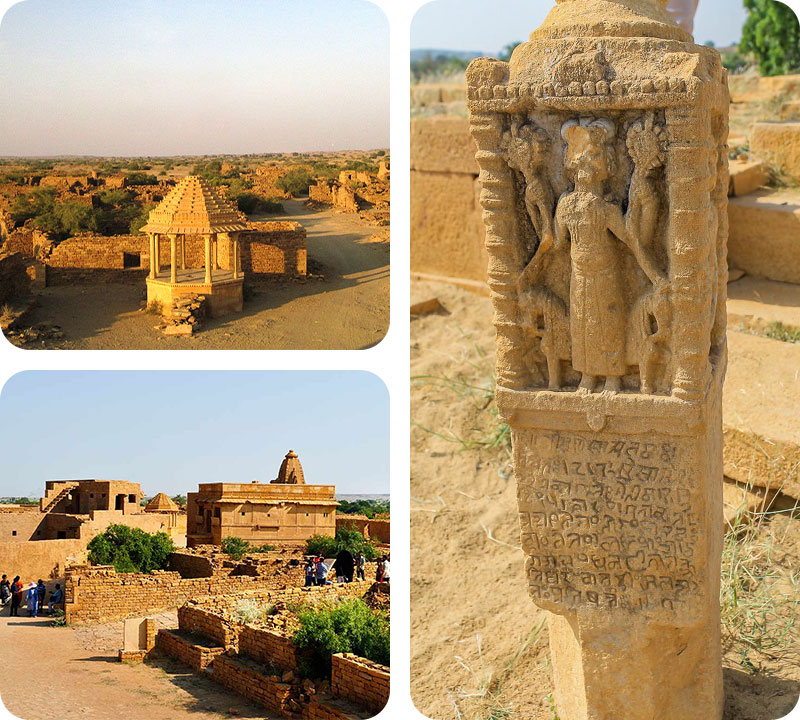
Kuldhara
Once upon a time, the village of Kuldhara was amongst the largest inhabited villages around Jaisalmer and was home to the Paliwal Brahmins. But, unfortunately the villagers from Kuldhara and 84 other villages abandoned their homes overnight to settle by the river Ganga (a holy Hindu river).
The legend says that Salim Singh (one of the king’s nobles) looked at a young teenage brahmin girl with bad intentions. So, in order to save the honour of the Brahmins, her parents killed the girl and all the villagers from Kuldhara & 84 other villages abandoned the place overnight.
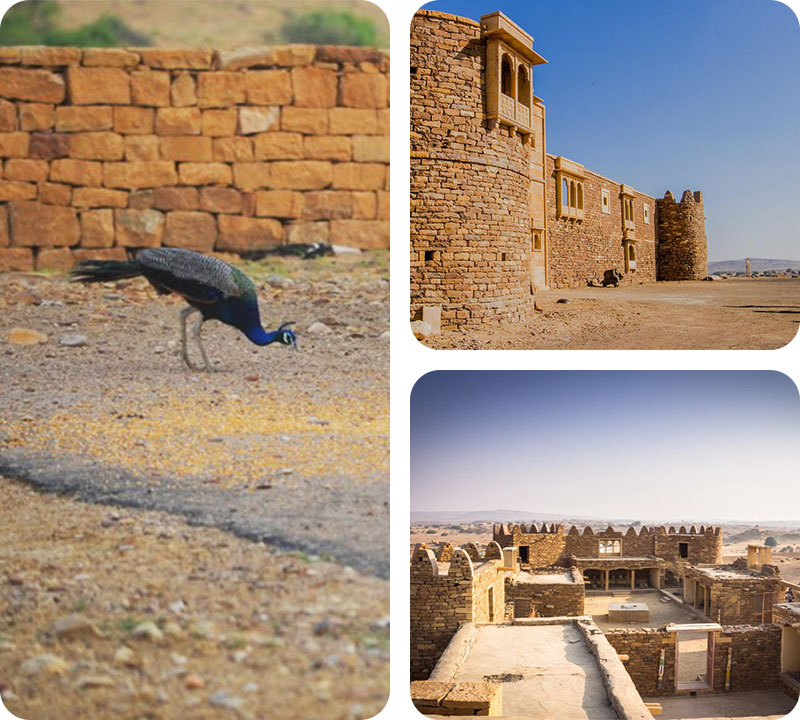
Khaba Fort
The Khaba Fort was once the home of the Maharaja, who later moved his capital to the Trikuta Hill (which now houses the Jaisalmer Fort) for strategic defense. After various attacks on Jaisalmer and due to the ingression by natural factors, the Khaba village and the fort, both lie in ruins today.
Its advisable to wake up early to witness a remarkable spectacle of a huge flock of peacocks that gathers around sunrise to have their breakfast which is fed by a local village boy. Apart from the peacocks, you can explore the fort from an archaeological aspect and enjoy a nice view of the village below.
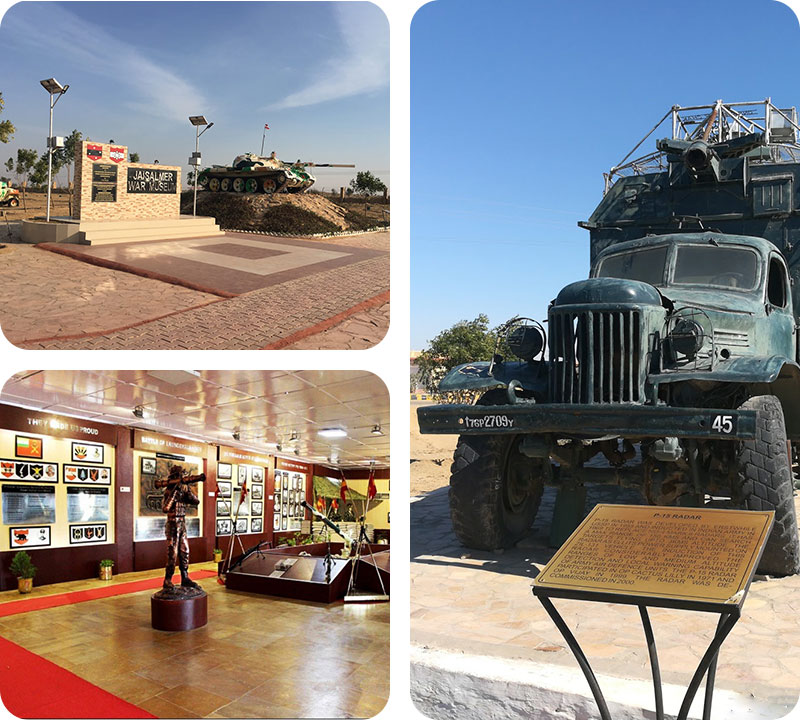
Jaisalmer War Museum
The Jaisalmer War Museum is dedicated to the victory of the Indian Army in the 1965 Indo-Pak War and the 1971 Longewala battle. It covers all aspects of the history and the journey of the Indian army during the war. One can see a lot of captured Pakistani vehicles and equipment that was used in the war.
The museum also has a war memorial made from the murals of all the martyrs who lost their lives while defending our country (India) in the war against Pakistan. Moreover, there is an audio-video theatre within the museum where a movie on the Battle of Longewala is showcased everyday.
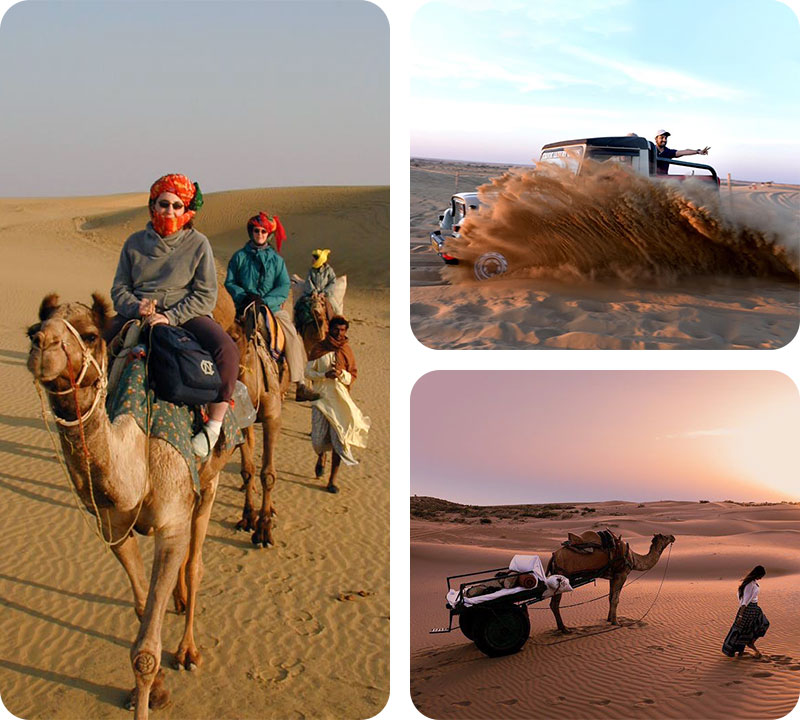
Sand Dunes
The major attraction in Jaisalmer apart from the fort is the sand dunes. There are two popular sand dunes in Jaisalmer i.e. Sam Sand Dunes and Khuri Sand Dunes. They both attract hordes of tourist each day and lie within a vicinity of around 40-50 km from Jaisalmer, but in different directions.
The major difference between the two is that Sam receives a lot of footfall while Khuri is peaceful with less tourists. Moreover, one can sleep amidst the dunes in the open or in a desert camp at any of these dunes and there are lots of activities to enhance your experience like jeep safari, camel safari, camel cart, etc.
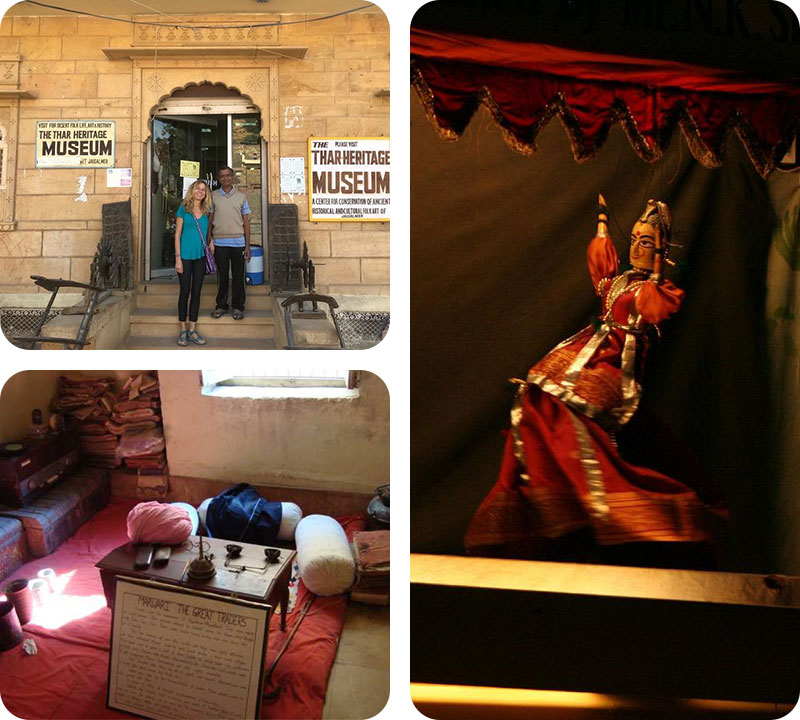
Thar Heritage Museum
The Thar Heritage Museum is a privately owned and operated museum that was setup by Mr. L. N. Khatri. This museum is an ideal place to visit especially if you’re keen on learning more about the history and the folklore of Jaisalmer. This museum even has an enchanting puppet show every evening.
Some of the artefacts in the museum include fossils, photographs, portraits, sculptures, coins, weapons, turbans, documents & manuscripts, etc. There is even a quaint handicrafts shop by the name of Desert Handicrafts adjoining the museum, where you can buy some classic souvenirs.
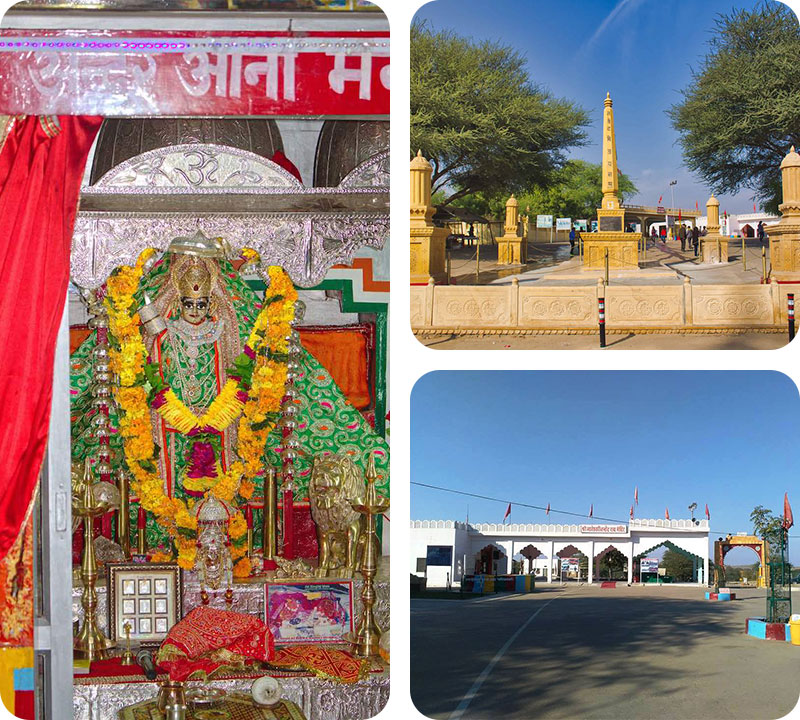
Tanot & Longewala
The Tanot & Longwala area came to fame due to the Bollywood Blockbuster ‘Border’ that was released in 1996. The film was based on the Battle of Longewala (1971) where India secured a victory over Pakistan. There is a War Museum situated in Longewala which also houses various captured Pakistani vehicles & equipment.
Apart from the Museum in the Border Area between India & Pakistan, there is another major attraction nearby, i.e. the Tanot Mata Temple, which is taken care of by the Border Security Force (BSF). It is said that Pakistani army dropped around 3000 bombs on the temple but none of them exploded.
COVID SAFETY
We care for you!
We believe in the 'One Family' policy and hence we abide by our duty to follow all Covid Safety Measures to safeguard you, your loved ones & those who are working with us.
Call us at +91 982 892 9974
Email us at [email protected]
Get directions on Google Maps
Find us on Tripadvisor
or fill the form below to reach us

Attractions in Jaisalmer
Enhance your trip to Jaisalmer by learning a bit more
about some of the popular major attractions in Jaisalmer.

Jaisalmer Fort
The Jaisalmer Fort is among the most lively historical monuments in the world that is definitely worth a visit. It was built by Maharaja Jaisal Singh in 1156 AD and is considered the second oldest fort in Rajasthan. The unique thing about the Jaisalmer Fort is that it still serves as the abode for over 3000 people.
Its well-planned archaeological design with narrow to wide lanes surely gives you a glimpse of the begone era of the Royals. The fort is constructed using yellow sandstone that changes its colours throughout the day, earning it the name of the ‘Golden Fort’ or ‘Sonar Killa’.
Havelis in Jaisalmer
As Jaisalmer flourished under a dynasty and served as a trade center in the begone era, it got some unique archaeological marvels making it popular as the ‘City of Havelis’. These havelis were constructed either in pure Rajputana architecture or a blend of Rajputana & Mughal architecture and are a must visit attraction.
There are only 3 major havelis in Jaisalmer which in order of their build period are Patwo ki Haveli, Nathmal ki Haveli and Salim Singh ki Haveli. All these havelis are now preserved as heritage museums and are quite popular tourist attractions which are open to the public during regular work hours.


Jain Temples in Jaisalmer
As Jaisalmer lied on the wealthy silk route, it was home to various jain traders and attracted various looters & invaders. Tired of the invaders, King Jaisal Raval built the fort to safeguard its people and the interest of the Jains. In return, the wealthy Jains financed the construction of the Fort.
There are various ancient Jain temples within the fort and a few are around the city, which act as a major pilgrimage site for the Jains. Moroever, these Jain temples contain beautiful frescoes, mirrors and other forms of detailing that are the perfect example of the Dilwara style architecture.
Gadisar Lake
The Gadisar lake was also built by Raja Jaisal Singh in 1156 AD to quench the thirst of the people of his kingdom. It is a major tourist attraction in Jaisalmer and this beautiful man-made lake is surrounded by temples, shrines and a forest area which acts as the perfect backdrop for picturesque photographs.
There are a few ancient temples on the banks that are dedicated to Lord Shiva and the stairs serve as an ideal romantic spot to watch the enchanting sunset. One can enhance his/her staying experience by opting to boat in the lake. The ideal time for visiting the lake is either before 11:00 AM or after 4:30 PM.


Amar Sagar
Amar Sagar is famous for its beautiful lake that was built by Raja Akhai Singh for his predecessor Raja Amar Singh during the 17th century. The lake was re-built by Patwa Bafna Himmat Ram in 1928 and boasts of beautiful stone carvings in the temples adjacent to the lake.
The calm water of the lake brings in a feeling of peace and solitude. There is also a famous, yet beautiful Jain temple situated nearby which is dedicated to Lord Parshvanath. The best time to visit the lake is also before 11 am and after 4:30 pm. The lake is considered auspicious and boating is not allowed here.
Bada Bagh
The Bada Bagh is the cremation site for the royals of Jaisalmer i.e. the kings, his nobles and some brave warriors. The place basically means a ‘big garden’, a garden of beautifully carved cenotaphs and is one of the major tourist attraction in Jaisalmer. It has its own vibe and you’ll find it quite calm & peaceful here.
This place provides a glimpse into the history of Jaisalmer and in order to preserve its heritage and worthiness, you will not find any description stones or inscriptions here. It is a popular tourist attraction for photoshoots and the best time to visit it is either early morning or in the evening.


Vyas Chattri
The Vyas Chattri has also been used as the cremation site for the Brahmins of Jaisalmer. This place is situated next to the city and also looks much like the Bada Bagh. It has a lot of cenotaphs or chattris but they are fewer in number here as compared to Bada Bagh.
This place is quite peaceful and it also offers a glimpse into the relations of the Brahmins with the Rajputs. It is also a popular tourist attraction where a lot of people come to take selfies and portraits. The best time to visit it is either early morning or in the evening.
Kuldhara
Once upon a time, the village of Kuldhara was amongst the largest inhabited villages around Jaisalmer and was home to the Paliwal Brahmins. But, unfortunately the villagers from Kuldhara and 84 other villages abandoned their homes overnight to settle by the river Ganga (a holy Hindu river).
The legend says that Salim Singh (one of the king’s nobles) looked at a young teenage brahmin girl with bad intentions. So, in order to save the honour of the Brahmins, her parents killed the girl and all the villagers from Kuldhara & 84 other villages abandoned the place overnight.


Khaba Fort
The Khaba Fort was once the home of the Maharaja, who later moved his capital to the Trikuta Hill (which now houses the Jaisalmer Fort) for strategic defense. After various attacks on Jaisalmer and due to the ingression by natural factors, the Khaba village and the fort, both lie in ruins today.
Its advisable to wake up early to witness a remarkable spectacle of a huge flock of peacocks that gathers around sunrise to have their breakfast which is fed by a local village boy. Apart from the peacocks, you can explore the fort from an archaeological aspect and enjoy a nice view of the village below.
Jaisalmer War Museum
The Jaisalmer War Museum is dedicated to the victory of the Indian Army in the 1965 Indo-Pak War and the 1971 Longewala battle. It covers all aspects of the history and the journey of the Indian army during the war. One can see a lot of captured Pakistani vehicles and equipment that was used in the war.
The museum also has a war memorial made from the murals of all the martyrs who lost their lives while defending our country (India) in the war against Pakistan. Moreover, there is an audio-video theatre within the museum where a movie on the Battle of Longewala is showcased everyday.


Sand Dunes
The major attraction in Jaisalmer apart from the fort is the sand dunes. There are two popular sand dunes in Jaisalmer i.e. Sam Sand Dunes and Khuri Sand Dunes. They both attract hordes of tourist each day and lie within a vicinity of around 40-50 km from Jaisalmer, but in different directions.
The major difference between the two is that Sam receives a lot of footfall while Khuri is peaceful with less tourists. Moreover, one can sleep amidst the dunes in the open or in a desert camp at any of these dunes and there are lots of activities to enhance your experience like jeep safari, camel safari, camel cart, etc.
Thar Heritage Museum
The Thar Heritage Museum is a privately owned and operated museum that was setup by Mr. L. N. Khatri. This museum is an ideal place to visit especially if you’re keen on learning more about the history and the folklore of Jaisalmer. This museum even has an enchanting puppet show every evening.
Some of the artefacts in the museum include fossils, photographs, portraits, sculptures, coins, weapons, turbans, documents & manuscripts, etc. There is even a quaint handicrafts shop by the name of Desert Handicrafts adjoining the museum, where you can buy some classic souvenirs.


Tanot & Longewala
The Tanot & Longwala area came to fame due to the Bollywood Blockbuster ‘Border’ that was released in 1996. The film was based on the Battle of Longewala (1971) where India secured a victory over Pakistan. There is a War Museum situated in Longewala which also houses various captured Pakistani vehicles & equipment.
Apart from the Museum in the Border Area between India & Pakistan, there is another major attraction nearby, i.e. the Tanot Mata Temple, which is taken care of by the Border Security Force (BSF). It is said that Pakistani army dropped around 3000 bombs on the temple but none of them exploded.